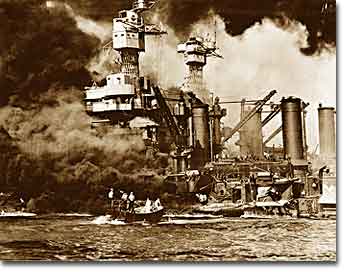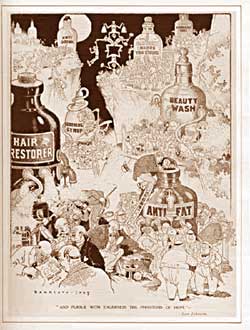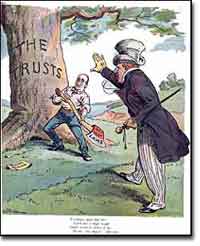
11. Policy Making: Political Interactions
Congress, the President, the Cabinet, advisers, agency bureaucrats, federal and state courts, political parties, interest groups, the media...All of these groups interact to make political decisions in the United States.
Public policy is a goal-oriented course of action that the government follows in dealing with a problem or issue in the country. Public policies are based on law, but many people other than legislators set them. Individuals, groups, and even government agencies that do not comply with policies can be penalized. This complicated process goes through a predictable series of steps:

The power to formulate and implement policy is often divided between several entities. Defense policy is a good example: after the bombing of Pearl Harbor, shown here, President Franklin Roosevelt addressed a joint session of Congress to ask the body to declare war against Japan.
1. Recognizing the problem.
At any given time, many conditions disturb or distress people, such as unsafe workplaces, natural disasters like tornadoes and earthquakes, crime, pollution, or the cost of medical care. But all disturbing conditions do not automatically become problems. People have to recognize that government can and should do something about them. For example, most citizens probably do not expect government to prevent hurricanes. However, they may expect government to help hurricane victims through quick relief actions.
2. Agenda setting.
An agenda is a set of problems that government wants to solve. Usually there are so many of them that they must be prioritized, with some problems getting earlier and more attention than others. Agenda setting may respond to pressure from interest groups, political parties, the media, and other branches of government. Agendas usually are reshaped when a new president takes office or when the majority party in Congress changes after an election. A crisis such as war, depression, natural disasters, or a tragic accident, almost always re-prioritizes issues.
3. Formulating the policy.
At this stage, usually several conflicting plans from various political interests take shape. Various players — the president and White House aides, agency officials, specially appointed task forces, interest groups, private research organizations, and legislators — may take part in formulating new policy.

Around the turn of the 20th century, muckrakers and concerned citizens brought to light the unethical practices rampant in the food and medicine industries and pressed the government to take action. The result was legislation such as the Pure Food and Drug Act of 1906, and eventually the creation of regulatory agencies like the Food and Drug Administration.
4. Adopting the policy.
Once various plans are presented, one policy is accepted by the decision-makers. In many cases, a policy is adopted when Congress passes a law. Policy adoption may also take place when the president signs an executive order or when the Supreme Court rules on an important case. Policy is often built in a series of small steps passed over time by different players, and eventually, a complex policy emerges.
5. Implementing the policy.
Most public policies are carried out by administrative agencies in the executive branch, although sometimes the courts get involved in implementing decisions they make. Agencies use many techniques to see that policy is carried out. Sometimes they punish people and organizations who do not comply with policy. For example, a state can take a driver's license away from a bad driver. Or the government may offer incentives, like tax breaks for contributing to the presidential election campaign. They even appeal to people's better instincts, such as using the slogan, "Only you can prevent forest fires."

Formulating policy involves weighing options, leading to dilemmas. This cartoon pokes fun at Teddy Roosevelt: Roosevelt was called a "trust buster" because of his strict antitrust policies, but he stays the hand of Attorney General Knox because he needs business contributions for his presidential campaign.
6. Evaluating the policy.
Policy makers often try to determine what a policy is actually accomplishing or whether or not it is being carried out efficiently. Often the evaluation process takes place over time with contributions from many of the interacting players. Most evaluations call for some degree of change and correction, and inevitably, at least some of the players will disagree. The whole process then begins again, starting with re-recognition of the problem.
Decision-making, then, is a continuous process with numerous people participating. At any given time, government is at various stages of policy-making in a never-ending quest to provide solutions to countless societal problems.






